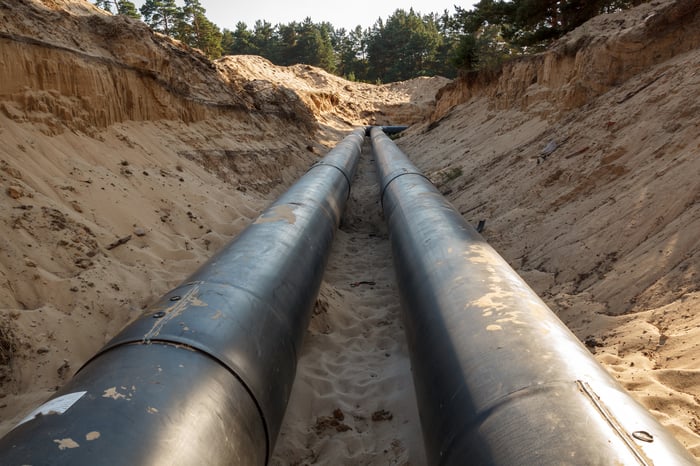Two years ago, TransCanada (TRP 0.10%) unveiled a bold plan to grow its lucrative dividend. After securing a 13 billion Canadian dollar ($10.1 billion) backlog of high-return growth projects, the company believed it had the fuel needed to increase its payout by an average annual rate of 8% to 10% through 2020, which was an acceleration from its previous growth rate of 7%. That said, after securing several more growth projects and buying a fast-growing natural gas pipeline company in the U.S., that backlog is up to more than CA$24 billion ($18.7 billion), which the company now believes will fuel dividend growth toward the upper end of its guidance range.
However, that increased backlog means the company will need more money to finance expansion. One of the sources it has tapped into is its renewable energy portfolio, which it has been selling off. In doing so, TransCanada seems to be making it clear that fossil fuels will continue powering its 4% yielding dividend and driving growth.

Image source: Getty Images.
Trading solar for more financial flexibility
TransCanada is one of the biggest energy infrastructure companies in North America, boasting one of the continent's largest natural gas pipeline networks as well as a top-tier liquids pipeline system. The company is also one of the leading private sector power generators in Canada, operating 12 plants that generate enough electricity to power 10 million homes, a third of which comes from clean energy sources like nuclear, wind, and solar.
That said, the company has taken a notable step away from renewables in the past year. Just this week, it announced a deal to sell its Ontario solar portfolio for CA$540 million ($421.4 million). In commenting on the sale, CEO Russ Girling stated that "this transaction demonstrates our financial discipline as we continue to build on our vision of being North America's leading energy infrastructure company." What's interesting about those comments is that solar doesn't seem to be part of TransCanada's vision.

Image source: Getty Images.
Cashing in on clean power
This transaction marks the company's third renewable power sale over the past year, which I've summed up in the following table:
|
Month |
Sale price ($US) |
Assets |
|---|---|---|
|
Closed in April |
$1.065 billion |
13 hydroelectric facilities in New England with 584 MW of capacity |
|
Closed in June |
$2.2 billion |
Three natural gas and one wind facility in the U.S. with 4,000 MW of capacity |
|
Accounted in October |
$421.4 million |
Eight solar facilities in Ontario with 76 MW of capacity. |
Source: TransCanada.
The company used the proceeds from the first two sales to pay off the bridge loan it took out to help finance its gas pipeline acquisition. Meanwhile, CEO Russ Girling noted that "the proceeds from this [solar] sale will help fund our CA$24 billion near-term capital program while maximizing value for our shareholders." In other words, Girling believes that TransCanada can deliver a higher value for its investors by selling these solar assets instead of expanding that portfolio.
That's worth noting because while TransCanada is selling off its renewable assets, rival Enbridge (ENB 0.40%) is taking the opposite approach. The company already owns one of the largest wind and solar power generating portfolios in Canada along with several renewable power facilities in the U.S., which supply about 2% of its earnings. However, Enbridge plans to make renewables an even bigger slice of that pie in the coming years by investing as much as CA$7.4 billion ($5.8 billion) in building offshore wind farms in Europe. The driving force behind these investments is that Enbridge can earn mid-teens returns, which is comparable to what it can make on new pipeline projects. Because of that, it makes financial sense to build and hold these assets since they'll put the company in a better position to achieve its goal of increasing the dividend by a 10% to 12% compound annual rate through 2024. TransCanada, likewise, would probably build more renewable assets if they generated the returns needed to drive high-end dividend growth.
It all boils down to returns
TransCanada isn't selling down its renewable energy portfolio due to a dim view on the sector but because it can generate better returns for investors by reinvesting that money into oil and gas pipeline projects. One of the driving forces behind that decision is that it signed lucrative long-term contracts with customers that need these projects to support their growth. Those agreements will provide TransCanada with high investment returns via predictable cash flow streams that put it on the path to continue increasing its dividend at a rapid rate. Because of that, investors who, like TransCanada, believe that that the world won't end its addiction to fossil fuels anytime soon, have the opportunity to lock in a compelling blend of growth in income by investing in its stock.





